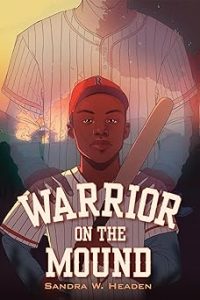How Family and Regional History Shaped the Narrative for Warrior on the Mound
How Family and Regional History Shaped the Narrative for Warrior on the Mound
By Sandra W. Headen
 The inspiration for my historical middle grade novel, Warrior on the Mound, started with adoration for my maternal grandfather, Arthur Moore. He was a sharecropper, a jack of all trades, superintendent of Sunday School at the church his father founded. In hog killing season, he was a butcher and a marksman whose skills were in high demand. In my debut novel, Warrior on the Mound, I wanted to write a story about how a Black family living in the Jim Crow South could raise a boy to become the strong and fearless Black man that I believed my grandfather to be.
The inspiration for my historical middle grade novel, Warrior on the Mound, started with adoration for my maternal grandfather, Arthur Moore. He was a sharecropper, a jack of all trades, superintendent of Sunday School at the church his father founded. In hog killing season, he was a butcher and a marksman whose skills were in high demand. In my debut novel, Warrior on the Mound, I wanted to write a story about how a Black family living in the Jim Crow South could raise a boy to become the strong and fearless Black man that I believed my grandfather to be.
One of the most interesting features of the writing process for the book was discovering the similarities between writing historical fiction and writing science fiction. World-building is a critical feature of each. Readers haven’t lived in the past nor have they lived on other planets or in other dimensions. Thus, it is the writer’s job to create a believable setting to serve as a home for characters and conduit for action.
The challenge then is to develop characters with interesting personalities and compelling motivations who fit into these environments. Their adventures must capture readers’ interest from the start and grip them until the very end. As I am now in the process of writing my second historical novel, it is clear to me that these are the steps that I must take to produce a satisfying book, but for the debut novel, these revelations unfolded very slowly.
When I first started writing, all that I had to go on was the spirit of my grandfather. Research to the rescue! As I had hoped, the research that I did on the history of North Carolina and on middle grade fiction led to the discovery of historical figures who set my imagination on fire.
From the resulting storm of ideas, it was clear from the start that my main character in Warrior on the Mound, Cato Octavius Jones, would be a baseball player. This decision flowed from my discovery of the book, We Are the Ship: The Story of Negro League Baseball by Kadir Nelson. The beautiful paintings in this book introduced me to a world of outstanding Black baseball players.
I had never heard of the Negro Leagues. Like most people, I thought that Black Americans were introduced to baseball in 1947 when Jackie Robinson joined the Brooklyn Dodgers.. I was so impressed by the accomplishments of Negro League players that I named Cato’s baseball team, the Pender County Rangers, after real life players. I also incorporated actual players, like the pitcher, Satchel Paige, into Cato’s narrative.
I was also overjoyed to find a historical figure who could serve as the namesake for my main character. Octavius Valentine Catto was an amateur baseball player, high school principal and social activist who lived in Chicago in the 1840-1870’s. He played with the Philadelphia Pythians and was known for challenging white teams to play against them, thus promoting integration in the game during a time when segregation was the norm.
Completing Warrior on the Mound taught me some other valuable lessons about writing historical fiction.
(a) Develop a believable historical world that both you and your protagonist can live in.
In Warrior on the Mound, Cato’s story was told in the first person. That means that from the moment Cato was ‘born’ until this very day, he resides in my consciousness. The more believable his world, the more seamless he can move around in it and the more enjoyable it is to be the author of his life.
(b) Develop a world of characters that you like. You will be living with them for a long time.
(c) Don’t be afraid to incorporate the complexities of history into world- building for your fictional characters. As a North Carolinian, I learned about the insurrection in Wilmington in 1898 and incorporated it into the narrative of Cato’s family. For me, it made their story more authentic.
(d) Don’t be afraid to introduce new swaths of history into a fictional world for young readers. I felt a special joy in incorporating so much about Negro League baseball into Cato’s story. After reading Warrior on the Mound, readers will know more about the marvelous players in this League and I hope they will be curious enough to find out more on their own.
In conclusion, I enjoyed writing Warrior on the Mound, in part because I liked the characters in the book, their relationships with each other, and even the ways in which the antagonists challenged the main characters. I was overjoyed to share with young readers the history of Negro League baseball and the history of my home state of North Carolina that I was not familiar with prior to writing the book. I write historical fiction to show young readers that some of the challenges that they face today were present in the lives of young people in the past. I want the stories that I tell to be instructive for them as they struggle with issues in the present and plan for the future.
—
Sandra W. Headen, PHD, Social and Community Psychologist, former faculty and researcher at The School of Public Health, University of North Carolina at Chapel Hill, is now a full-time writer. Her short story “Papa’s Gifts” (The Carolina Quarterly, March 2019) was awarded the Jacob-Jones African-American Literary Award by the North Carolina Writers’ Network. Warrior on the Mound won SCBWI’s On-the-Verge/Emerging Voices Award for writers from underrepresented groups. Warrior on the Mound is also a Junior Library Guild Gold Standard Selection and received a Kirkus Starred review.
Facebook Sandra Headen
X @HeadenSandra
Instagram sndr.bellenoire29
LinkedIn Sandra Headen
WARRIOR ON THE MOUND
 Narrated by twelve-year-old Cato, this intense and evocative story of racial unrest in prewar North Carolina ends with a dramatic match between white and Black little league teams.
Narrated by twelve-year-old Cato, this intense and evocative story of racial unrest in prewar North Carolina ends with a dramatic match between white and Black little league teams.
1935. Twelve-year-old Cato wants nothing more than to play baseball, perfect his pitch, and meet Mr. Satchel Paige––the best pitcher in Negro League baseball. But when he and his teammates “trespass” on their town’s whites-only baseball field for a practice, the resulting racial outrage burns like a brushfire through the entire community, threatening Cato, his family, and every one of his friends.
There’s only one way this can end without violence: It has to be settled on the mound, between the white team and the Black. Winner takes all.
Written in first person with a rich, convincing voice, Warrior on the Mound is about the experience of segregation; about the tinderbox environment of the prewar South; about having a dream; about injustice, and, finally, about dialogue.
Back matter includes an author’s note, historical background, biographical information about Negro League players, and more.
A Junior Library Guild Gold Standard Selection
“A HOME RUN.”—School Library Journal, starred review
“NOT TO BE MISSED.”—Kirkus Reviews, starred review
BUY HERE
Category: On Writing
























